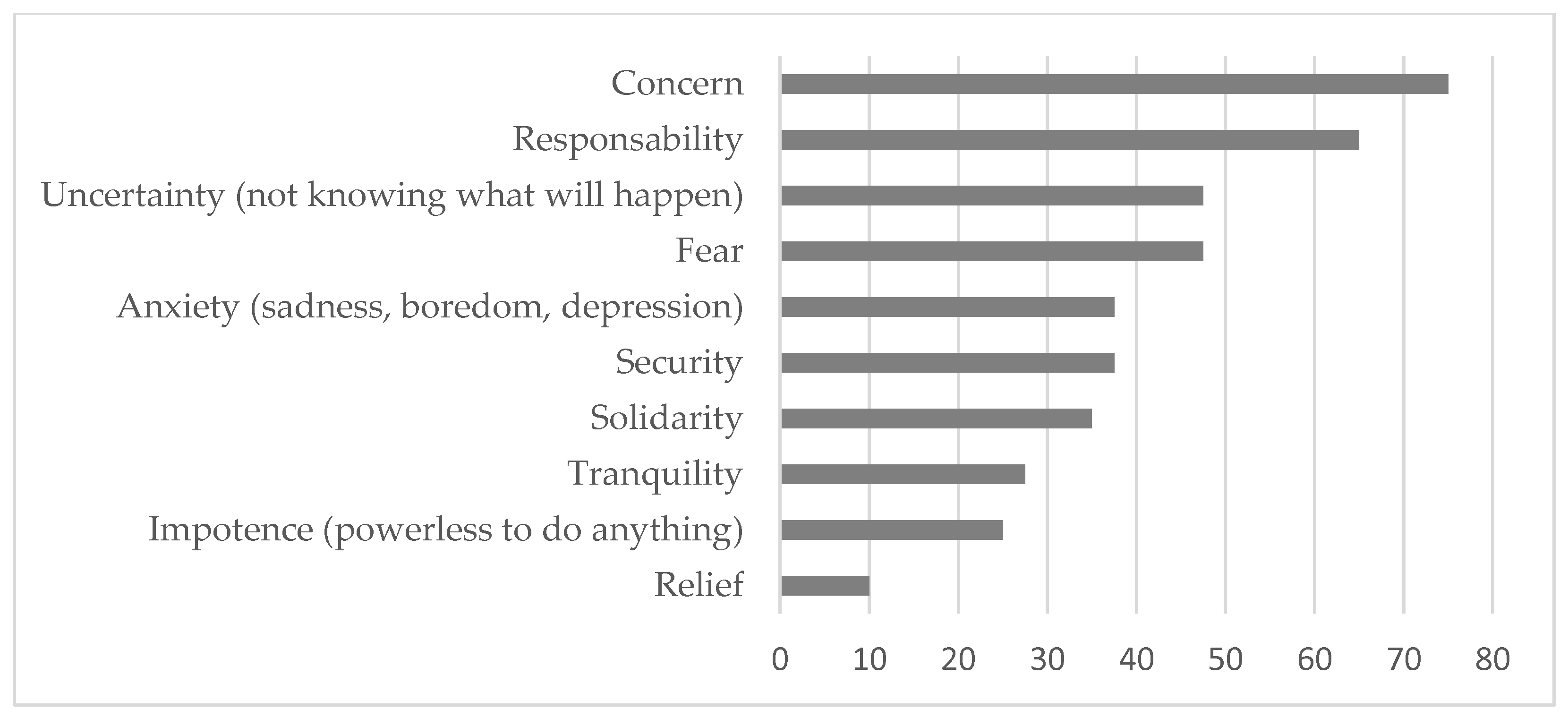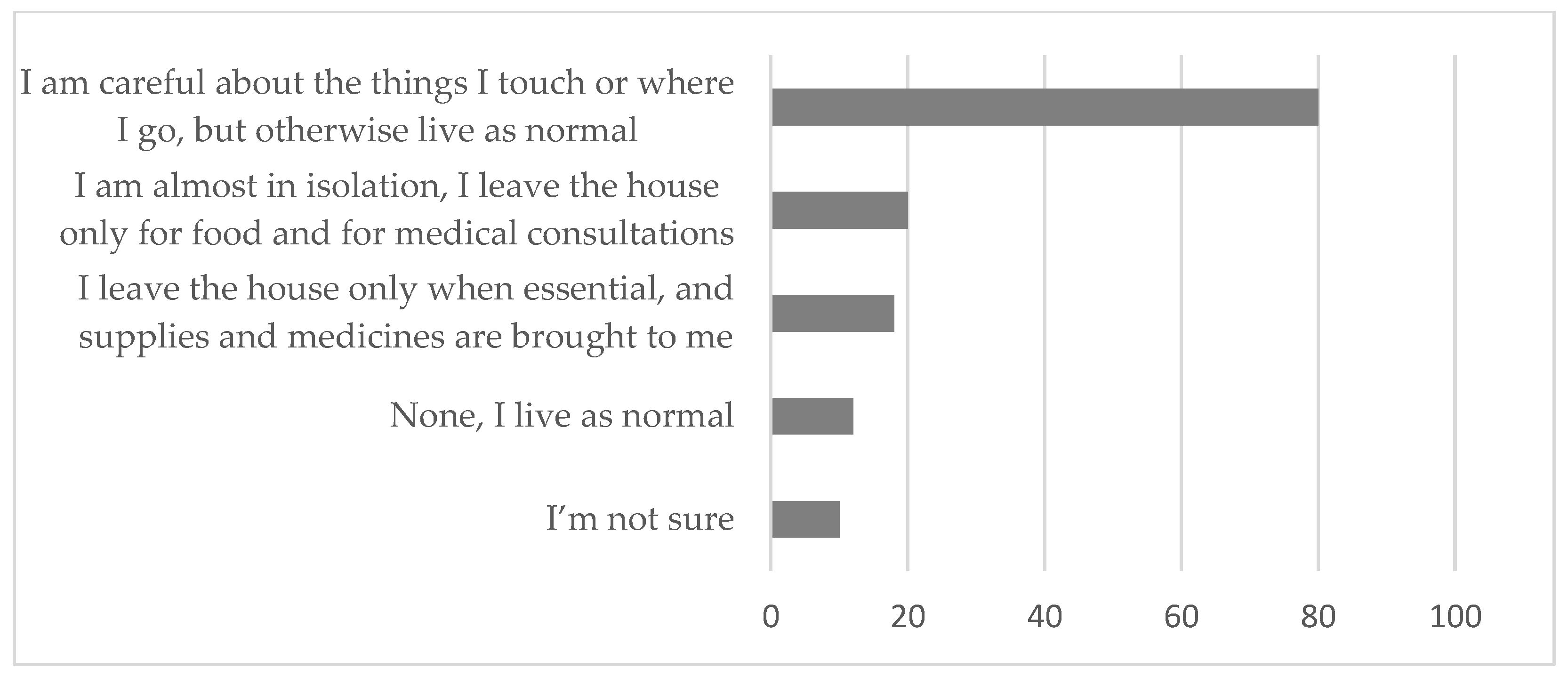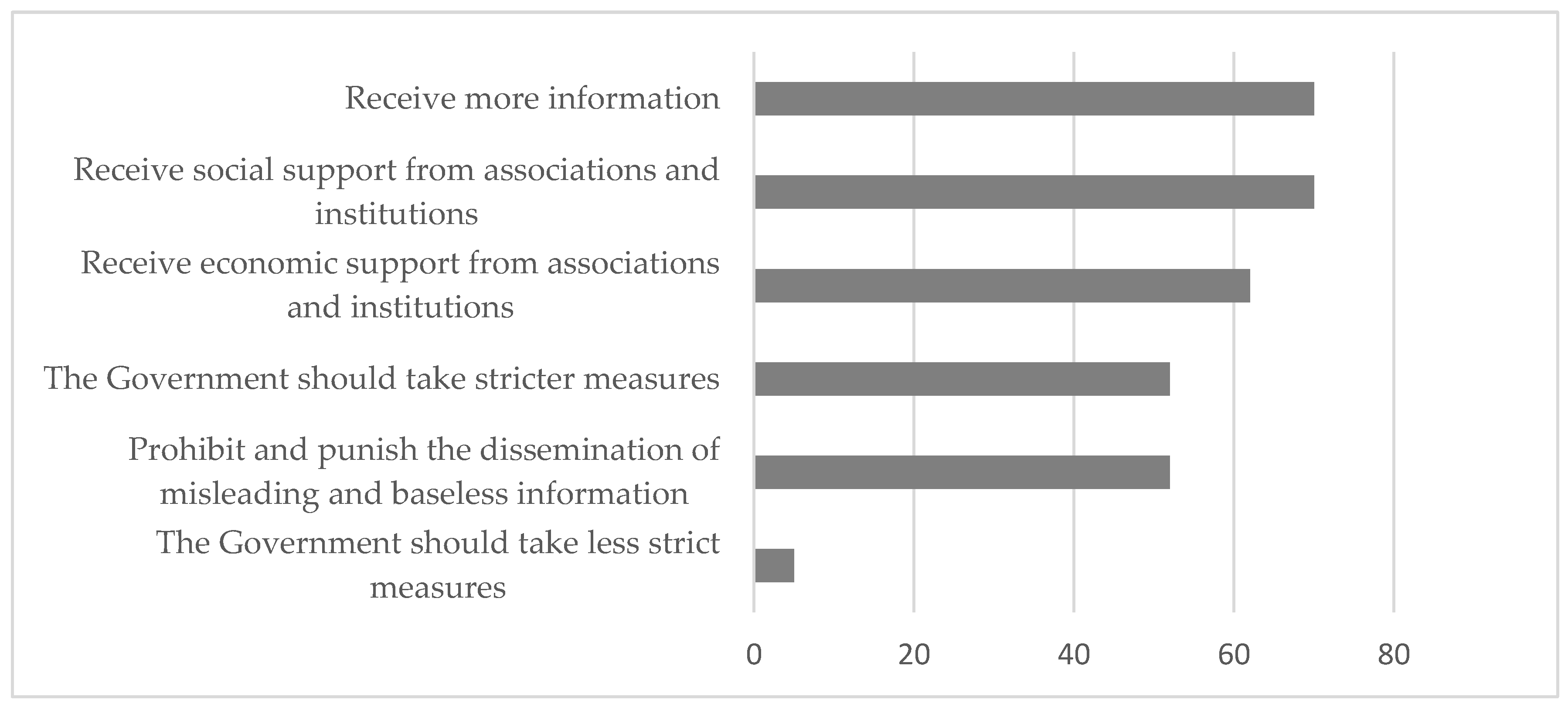Perception of the Impact of COVID-19 on a Sample of Spaniards with Hearing Disabilities
Abstract
1. Introduction
2. Materials and Methods
2.1. Participants
2.2. Instruments
- For emergency telephone numbers (061, 112…) to be directly accessible in writing or by video call.
- For communication between the patient and the health system to be facilitated through instant messaging or written text.
- For health emergency telephone numbers and others to communicate that you have symptoms of COVID-19, carry out follow-ups, etc., to offer the possibility of using instant messaging or written text.
- Improve access to health information. Guarantee an adequate state of health, compliance with guidelines, and/or treatments.
- Monitoring of health status so that health is not threatened due to lack of information.
- Generalization of the use of approved transparent masks by those who serve the public in order to guarantee accessibility for deaf people. Opaque masks do not allow one to read lips or interpret emotions.
- For the audiovisual communication media to rigorously broadcast information with subtitles and in SL in a window where the interpreter is of adequate size and resolution.
- Facilitate complete accessibility to online videos, where there is clarity and synchronization of text and voice to facilitate total understanding of the message.
- For official live communications from the authorities (health, politics, etc.) to be accessible in SL and with live voice-to-text subtitles.
- Improve the means for people with hearing disabilities to access remote (online) education: SL interpreter, subtitled classes, visualization of the teachers’ lips, sufficient and adequate explanations for students with deafness, sufficient print media materials, and videos with rigorous subtitling.
- Improve the conditions for working from home: with SL interpreters, online meeting transcription, and government-subsidized speech-to-text facilities so that access to working life is not impeded.
- Install audio induction loop systems to enable communication and access to information for those who use hearing aids and cochlear implants.
- Financially guarantee the maintenance of hearing aids (batteries, spare parts, etc.).
2.3. Questionnaire Response Procedure
3. Results
4. Conclusions
Author Contributions
Funding
Institutional Review Board Statement
Informed Consent Statement
Conflicts of Interest
References
- Navas, P.; Verdugo, M.A.; Amor, A.M.; Crespo, M.; Martínez, S. COVID-19 y Discapacidades Intelectuales y del Desarrollo: Impacto del Confinamiento desde la Perspectiva de las Personas, sus Familiares y los Profesionales y Organizaciones que Prestan Apoyo. In Plena Inclusión España e Instituto Universitario de Integración en la Comunidad (INICO); Universidad de Salamanca: Salamanca, Spain, 2020; Volume 1 or 6, pp. 170–191. [Google Scholar]
- Naciones Unidas. COVID-19 y Los Derechos de las Personas con Discapacidad: Directrices; Naciones Unidas: New York, NY, USA, 2020; pp. 1–9. Available online: https://www.ohchr.org/sites/default/files/Documents/Issues/Disability/COVID-19_and_The_Rights_of_Persons_with_Disabilities_SP.pdf (accessed on 3 May 2020).
- Mladenov, T.; Brennan, C. The global COVID-19 Disability Rights Monitor: Implementation, findings, disability studies response. Disabil. Soc. 2021, 36, 1356–1361. [Google Scholar] [CrossRef]
- Narada Insights. The Teenager Who Died in the Epidemic and the Relief Network behind Him. Available online: https://www.thepaper.cn/newsDetail_forward_6625716 (accessed on 4 May 2020).
- Dai, R.; Hu, L. Inclusive communications in COVID-19: A virtual ethnographic study of disability support network in China. Disabil. Soc. 2022, 37, 3–21. [Google Scholar] [CrossRef]
- Trecca, E.M.C.; Gerardi, M.; Cassano, M. COVID-19 and Hearing Difficulties. Am. J. Otolaryngol. 2020, 41, 102496. Available online: https://europepmc.org/backend/ptpmcrender.fcgi?accid=PMC7166300&blobtype=pdf (accessed on 22 June 2021). [CrossRef] [PubMed]
- Qi, F.; Wu, Y.; Wang, Q. Experience and Discussion: Safeguards for People with Disabilities During the COVID-19 Pandemic in China. Front. Public Health 2021, 9, 744706. Available online: https://pubmed.ncbi.nlm.nih.gov/34805070/ (accessed on 15 November 2021). [CrossRef] [PubMed]
- Jalali, M.; Shahabi, S.; Lankarani, K.B.; Kamali, M.; Mojgani, P. COVID-19 and disabled people: Perspectives from Iran. Disabil. Soc. 2020, 35, 844–847. Available online: https://www.tandfonline.com/doi/pdf/10.1080/09687599.2020.1754165 (accessed on 6 June 2020). [CrossRef]
- DHEC (Department of Health and Environmental Control). Available online: https://scdhec.gov/covid19/asl-covid-19-videos (accessed on 21 November 2022).
- CNSE (Confederación Estatal de Personas Sordas). Available online: https://cnse.es/index.php/noticias/item/759-requisitos-mascarillas-higienicas-y-transparentes (accessed on 21 November 2022).
- CNSE (Confederación Nacional de Personas Sordas). Sobre las Personas Sordas. Available online: https://cnse.es/index.php/personas-sordas (accessed on 1 January 2021).
- CERMI (Comité Español de Representantes de Personas con Discapacidad). Fiapas Pide al Gobierno Tener en Cuenta “las Desventajas y Discriminaciones” Sufridas por las Personas con Discapacidad Auditiva Durante la Pandemia. 2021. Available online: https://cermi.es/noticia/fiapas-pide-al-gobierno-tener-en-cuenta-las-desventajas-y-discriminaciones-sufridas-por-las-personas-con-discapacidad-auditiva-durante-la-pandemia (accessed on 1 July 2021).
- Federación de Asociaciones de Implantados Cocleares. Los Usuarios de Implante Coclear Exigen Mejor Accesibilidad a la Comunicación Durante la Pandemia. Available online: http://implantecoclear.org/index.php?option=com_content&view=article&id=561:2020-03-24-12-52-31&catid=1:latest-news&Itemid=50 (accessed on 26 March 2020).
- Emond, A.; Ridd, M.; Sutherland, H.; All, L.; Alexander, A.; Kyle, J. The current health of the signing Deaf community in the UK compared with the general population: A cross-sectional study. Br. J. Gen. Pract. 2015, 65, 95–96. Available online: https://bjgp.org/content/65/631/95 (accessed on 4 March 2021). [CrossRef] [PubMed]
- Bown, S.; Aldersson, R.; Dekesel, K. Supporting patients who are deaf who use a signed language in general practice. Br. J. Gen. Pract. 2020, 70, 10–11. Available online: https://bjgp.org/content/70/690/10 (accessed on 4 March 2021). [CrossRef] [PubMed]
- CEPAL (Comisión Económica para América Latina y el Caribe). “Personas con Discapacidad ante la Enfermedad por Coronavirus (COVID-19) en América Latina y el Caribe. Situación y Orientaciones”, Informes COVID-19. 2020. Available online: https://repositorio.cepal.org/bitstream/handle/11362/45491/S2000300_es.pdf?sequence=1 (accessed on 2 January 2021).
- Fernández Enguita, M. Una Pandemia Imprevisible ha Traído la Brecha Previsible. 2020. Available online: https://blog.enguita.info/ (accessed on 22 November 2022).
- WFD (Word Federation of Deaf). Position Statement on Educational Rights for Deaf Learners during the COVID-19 Pandemic and beyond. 2021. Available online: https://wfdeaf.org/news/resources/position-statement-on-educational-rights-for-deaf-learners-during-the-covid-19-pandemic-and-beyond/ (accessed on 22 November 2022).
- Ley 27/2007, de 23 de Octubre, por la que se Reconocen las Lenguas de Signos Españolas y se Regulan los Medios de Apoyo a la Comunicación oral de las Personas Sordas, con Discapacidad Auditiva y Sordociegas. Available online: https://www.boe.es/boe/dias/2007/10/24/pdfs/A43251-43259.pdf (accessed on 22 November 2022).
- OMS (Organización Mundial de la Salud). Sordera y Pérdida de la Audición. 2021. Available online: https://www.who.int/es/news-room/fact-sheets/detail/deafness-and-hearing-loss (accessed on 21 November 2022).
- WFD (Word Federation of Deaf). Statement on Accesible Communication for Deaf and Hard of Hearing People during COVID-19 Pandemic. 2020. Available online: https://wfdeafnew.wpenginepowered.com/wp-content/uploads/2020/08/IFHOHYP-WFDYS-Statement-Final-31aug20-1.pdf (accessed on 24 November 2022).
- FIAPAS (Confederación Española de Familias de Personas Sordas). Qué es la Sordera. Available online: http://www.fiapas.es/que-es-la-sordera (accessed on 21 November 2022).
- Schalock, R.L.; y Verdugo, M.A. Handbook on Quality of Life for Human Service Practitioners; American Association on Mental Retardation: Washington, DC, USA, 2002. [Google Scholar]
- Verdugo, M.A.; Arias, B.; Gómez, A.E.; Schalock, R.L. Escala GENCAT. Manual de Aplicación de la Escala GENCAT de Calidad de Vida; Departamento de Acción Social y Ciudadanía de la Generalitat de Cataluña: Barcelona, Spain, 2009. [Google Scholar]
- Centro de Investigaciones Sociológicas. Efectos y Consecuencias del Coronavirus. Avance de Resultados. Estudio nº 3346. Available online: https://www.cis.es/cis/export/sites/default/-Archivos/Marginales/3340_3359/3346/cues3346.pdf (accessed on 1 January 2021).
- Centro de Investigaciones Sociológicas. Tendencias en la Sociedad Digital Durante la Pandemia de la COVID-19. Avance de Resultados. Estudio nº 3316. 2021. Available online: https://www.cis.es/cis/export/sites/default/-Archivos/Marginales/3300_3319/3316/es3316mar.pdf (accessed on 1 January 2021).
- Centro de Investigaciones Sociológicas. Barómetro de Noviembre 2020. Avance de Resultados. Estudio nº 3300. Noviembre 2020. Available online: http://datos.cis.es/pdf/Es3300marMT_A.pdf (accessed on 1 February 2020).
- Silván, C.; Quífez, L.E. Efectos y Consecuencias de la Crisis de la COVID-19 Entre las Personas con Discapacidad. Fundación Once. Fondo Social Europeo. Unión Europea. 2020. Available online: https://www.odismet.es/sites/default/files/2020-07/Informe_EstudioCOVID_19_v3_0.pdf (accessed on 29 August 2020).
- Mhiripiri, N.A.; Midzi, R. Fighting for survival: Persons with disabilities’ activism for the mediatisation of COVID-19 information. Media Int. Aust. 2021, 178, 151–167. [Google Scholar] [CrossRef]
- Centro de Investigaciones Sociológicas; Centro de Investigaciones Sociológicas. Efectos y Consecuencias del Coronavirus (I). Estudio nº 3298. Octubre 2020. Available online: https://www.cis.es/cis/opencm/GA/1_encuestas/estudios/ver.jsp?estudio=14530 (accessed on 1 February 2020).
- Centro de Investigaciones Sociológicas. Efectos y Consecuencias del Coronavirus (II). Estudio nº 3302. Noviembre 2020. Available online: https://www.cis.es/cis/export/sites/default/-Archivos/Marginales/3300_3319/3302/es3302mar.pdf (accessed on 1 February 2020).
- Centro de Investigaciones Sociológicas. Efectos y Consecuencias del Coronavirus (II). Estudio nº 3305. Diciembre 2020. Available online: https://www.cis.es/cis/export/sites/default/-Archivos/Marginales/3300_3319/3305/es3305mar.pdf (accessed on 1 February 2020).








| Education Level | n | Percentage | Accumulated Percentage |
|---|---|---|---|
| Less than 5 years of schooling | 8 | 20.0 | 20.0 |
| Primary education | 6 | 15.0 | 35.0 |
| Professional qualification | 3 | 7.5 | 42.5 |
| Compulsory secondary education | 1 | 2.5 | 45.0 |
| Intermediate level VET | 3 | 7.5 | 52.5 |
| Baccalaureate | 1 | 2.5 | 55.0 |
| Higher level VET | 8 | 20.0 | 75.0 |
| Diploma | 5 | 12.5 | 87.5 |
| University degree | 3 | 7.5 | 95.0 |
| Bachelor’s degree | 1 | 2.5 | 97.5 |
| Master’s degree | 1 | 2.5 | 100.0 |
| Occupation | n | Accumulated Percentage |
|---|---|---|
| Working | 15 | 37.50 (37.5) |
| Retired or pensioner (I have worked before) | 11 | 27.50 (65) |
| Retired or pensioner (I have not worked before) | 4 | 10.00 (75) |
| Unemployed but I have worked before | 2 | 5.00 (80) |
| Unemployed and looking for my first job | 1 | 2.50 (82.5) |
| Unpaid housework | 1 | 2.50 (85) |
| Student | 4 | 10.00 (95) |
| Record of Temporary Employment Regulation | 2 | 5.00 (100) |
| Total | 40 | 100.00 (100) |
| M a | s | |
|---|---|---|
| Consequences arising from the hospitalization of a family member | 3.70 | 1.51 |
| Fear of getting infected by the coronavirus | 3.70 | 1.42 |
| Fear that a family member or close acquaintance will be infected with the coronavirus | 3.70 | 1.52 |
| That there will be another pandemic | 3.70 | 1.51 |
| The death of a friend or acquaintance | 3.65 | 1.53 |
| Worry about the coronavirus and its consequences on my health | 3.65 | 1.59 |
| Receive medical care if necessary | 3.63 | 1.58 |
| The death of a family member or person I live with | 3.60 | 1.72 |
| Worry about the coronavirus and its consequences on the health of other people | 3.57 | 1.55 |
| Fear of having a serious illness | 3.52 | 1.54 |
| The consequences of hospitalization | 3.47 | 1.59 |
| The illness of a family member or person I live with | 3.38 | 1.69 |
| The alteration of my family relationships | 2.88 | 1.64 |
| The change in my daily life | 2.85 | 1.66 |
| Dying | 2.85 | 1.79 |
| The process of dying | 2.83 | 1.88 |
| Feeling nervous | 2.75 | 1.72 |
| Being unable to control my worries | 2.73 | 1.71 |
| Feeling down or hopeless | 2.70 | 1.73 |
| That life will continue as it is now | 2.70 | 1.68 |
| The alteration of my relationships with friends | 2.65 | 1.49 |
| Feeling little interest in doing things | 2.63 | 1.60 |
| Having nightmares | 2.58 | 1.58 |
| Changes in the way of being of my relatives or people I live with | 2.47 | 1.58 |
| Loss of my job | 2.40 | 1.85 |
| Feeling overwhelmed | 2.28 | 1.65 |
| Crying | 2.25 | 1.61 |
| Changes in my way of being | 2.25 | 1.55 |
| Feeling alone | 2.18 | 1.60 |
| Being alone | 2.13 | 1.52 |
| n | Accumulated Percentage | |
|---|---|---|
| In sign language | 16 | 40.0 (40.0) |
| Oral | 2 | 5.0 (45.0) |
| Written | 5 | 12.5 (57.5) |
| In sign language, oral, and written | 2 | 5.0 (62.5) |
| Sign language and subtitles | 1 | 2.5 (65.0) |
| Sign language, written, and subtitles | 1 | 2.5 (67.5) |
| Sign and written language | 13 | 32.5 (100.0) |
| Measures Proposed to Improve the Quality of Life | Mean | SD |
|---|---|---|
| Audiovisual media with information with subtitles and in sign language in a window where the interpreter is large enough to be seen properly | 4.10 | 1.87 |
| More mechanisms for people with hearing disabilities to have access to a remote education (online) | 4.10 | 1.68 |
| More direct and faster access to health information that ensures an adequate state of health and follow-up | 3.93 | 1.72 |
| Emergency telephone numbers (061, 112…) for COVID-19, accessible by instant messaging or video call | 3.80 | 1.51 |
| Facilitate full accessibility to online videos with accuracy, articulacy, and synchrony of text and voice to enable complete understanding of the message. | 3.80 | 1.72 |
| Communication between the patient and the health system through instant messaging or written text | 3.73 | 1.42 |
| Online videos with synchrony of text and voice that enable the complete understanding of the message | 3.70 | 1.40 |
| That the health emergency telephone numbers and those supplying information on COVID-19 give the option of using instant messaging or written text | 3.68 | 1.62 |
| Use, by those serving the public, of transparent approved masks that facilitate lip-reading and interpretation of emotions | 3.55 | 1.40 |
| Conditions for working from home subsidized by the government. Sign language interpreters, transcription of online meetings, and voice-to-text facilities so that access to working life is not impeded. | 3.45 | 1.37 |
| Financially guarantee the maintenance of hearing aids (batteries, spare parts, etc.) | 3.33 | 1.28 |
| Installation of audio induction loops to enable communication and access to information for those who use hearing aids and cochlear implants. | 3.18 | 1.24 |
Disclaimer/Publisher’s Note: The statements, opinions and data contained in all publications are solely those of the individual author(s) and contributor(s) and not of MDPI and/or the editor(s). MDPI and/or the editor(s) disclaim responsibility for any injury to people or property resulting from any ideas, methods, instructions or products referred to in the content. |
© 2023 by the authors. Licensee MDPI, Basel, Switzerland. This article is an open access article distributed under the terms and conditions of the Creative Commons Attribution (CC BY) license (https://creativecommons.org/licenses/by/4.0/).
Share and Cite
Martínez Sánchez, M.Á.; Muñoz-García, A.; Ros Gil, C. Perception of the Impact of COVID-19 on a Sample of Spaniards with Hearing Disabilities. Int. J. Environ. Res. Public Health 2023, 20, 1460. https://doi.org/10.3390/ijerph20021460
Martínez Sánchez MÁ, Muñoz-García A, Ros Gil C. Perception of the Impact of COVID-19 on a Sample of Spaniards with Hearing Disabilities. International Journal of Environmental Research and Public Health. 2023; 20(2):1460. https://doi.org/10.3390/ijerph20021460
Chicago/Turabian StyleMartínez Sánchez, Mª Ángeles, Antonio Muñoz-García, and Cristina Ros Gil. 2023. "Perception of the Impact of COVID-19 on a Sample of Spaniards with Hearing Disabilities" International Journal of Environmental Research and Public Health 20, no. 2: 1460. https://doi.org/10.3390/ijerph20021460
APA StyleMartínez Sánchez, M. Á., Muñoz-García, A., & Ros Gil, C. (2023). Perception of the Impact of COVID-19 on a Sample of Spaniards with Hearing Disabilities. International Journal of Environmental Research and Public Health, 20(2), 1460. https://doi.org/10.3390/ijerph20021460








